- Techniques
- Kicks 차기
- History of Kicking
Taekwondo 태권도Taekwondo Preschool
Promotion from one geup to the next can proceed rapidly in some schools, since schools often allow geup promotions every two, three, or four months. Students of geup rank learn the most basic techniques first, and then move on to more advanced techniques as they approach first dan. Many of the older and more traditional schools often take longer to allow students to test for higher ranks than newer, more contemporary schools, as they may not have the required testing intervals. View Taekwondo belt levels »




History of Kicking
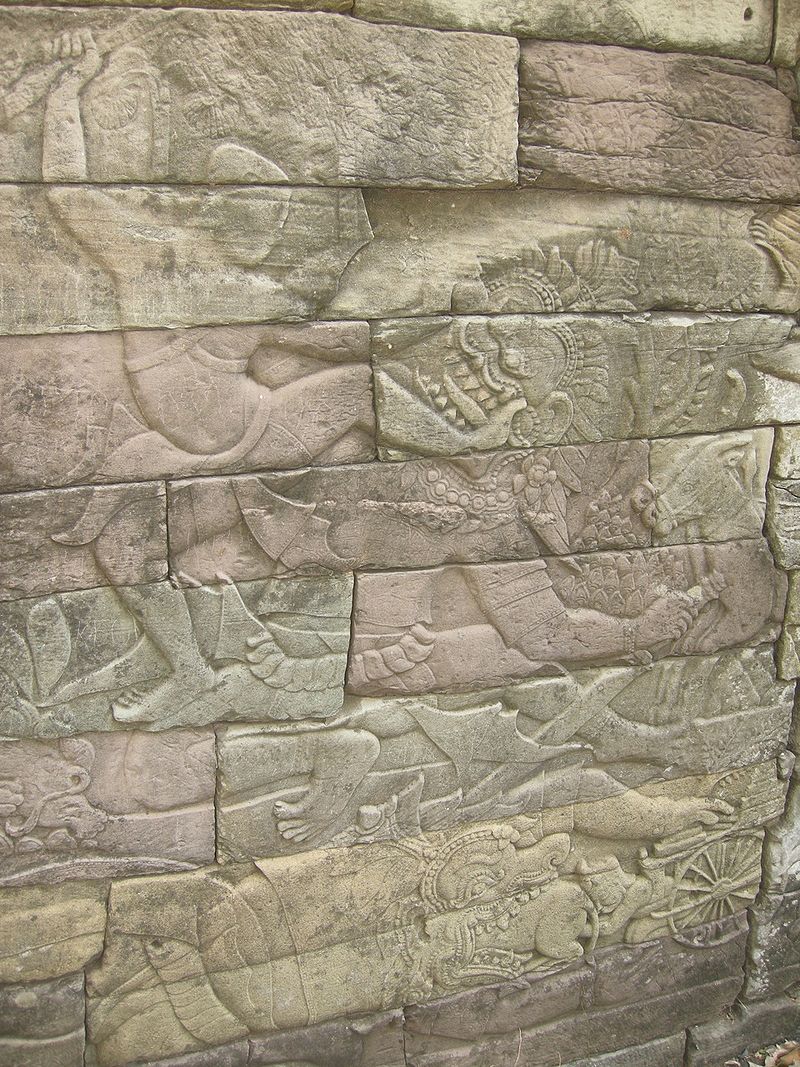
The English verb to kick appears only in the late 14th century, apparently as a loan from Old Norse, originally in the sense of a hooved animal delivering strikes with his hind legs; the oldest use is Biblical, in the metaphor of an ox kicking against the pricks.
Kicks as an act of human aggression have likely existed worldwide since prehistory. However, high kicks, aiming above the waist or to the head appear to have originated from Asian martial arts. Such kicks were introduced to the west in the 19th century with early hybrid martial arts inspired by Asian styles such as Bartitsu and Savate. Practice of high kicks became more universal in the second half of the 20th century with the more widespread development of hybrid styles such as kickboxing and eventually mixed martial arts.
The history of the high kick in Asian martial arts is difficult to trace. It appears to be prevalent in all traditional forms of Indochinese kickboxing, but these cannot be traced with any technical detail to pre-modern times. For example, Muay Boran or "ancient boxing" in Thailand was developed under Rama V (r. 1868-1910). While it is known that earlier forms of "boxing" existed during the Ayutthaya Kingdom, the details regarding these techniques are unclear. Some stances that look like low kicks, but not high kicks, are visible in the Shaolin temple frescoes, dated to the 17th century. The Mahabharata, an Indian epic compiled at some point before the 5th century AD, describes an unarmed hand-to-hand battle, including the sentence "and they gave each other violent kicks" (without providing any further detail).
For more information on the history of Martial Arts view Martial Arts Timeline ».

Did you know? Taekwondo Preschool Master Edition Available Now
Taekwondo Preschool Master Edition

The book Taekwondo Preschool Master Edition provides in-depth information on the explosive and powerful techniques of taekwondo. There are lots of illustrations and interactive content within the master edition guidebook with over 1500+ pages. Are you prepared to learn the Korean Martial Arts! The book is available for download with Apple Books on your Mac or iOS device, and with iTunes on your computer. Books can be read with Apple Books on your Mac or iOS device.
View more information about the book »
- Taekwondo Stances ( 서기 sogi )
- Taekwondo Blocking ( 막기 makgi )
- Taekwondo Kicking ( 차기 chagi )
- Taekwondo Fist Strikes ( 지르기 jireugi )
- Taekwondo Strikes ( 치기 chigi )
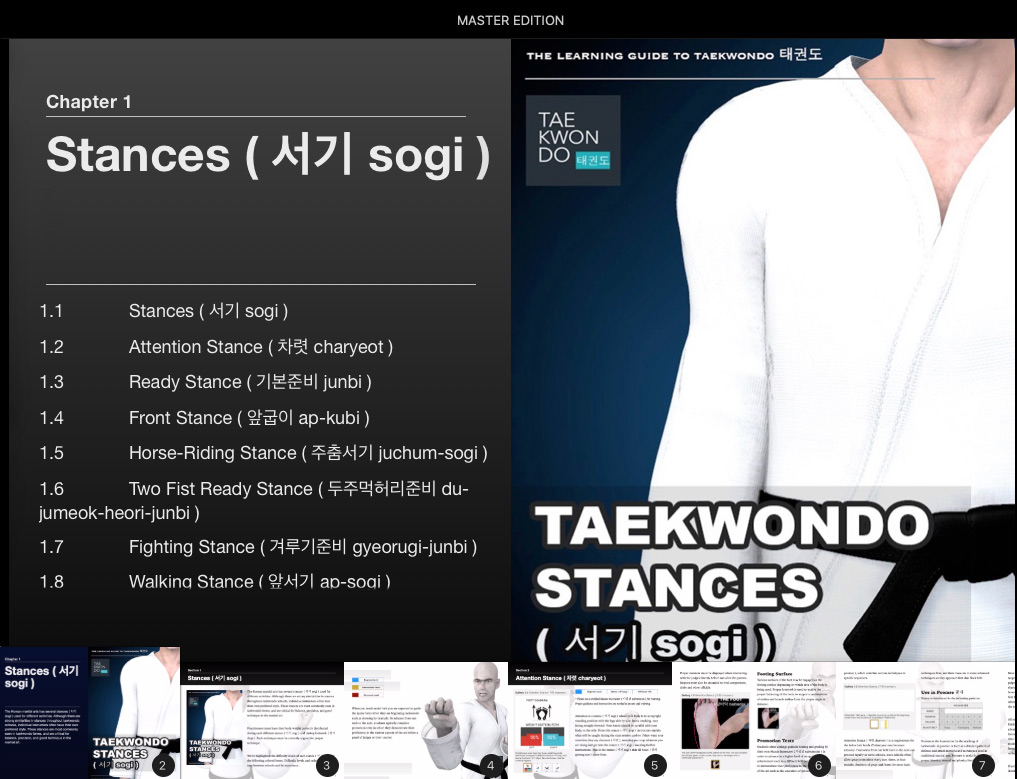
Taekwondo Preschool Master Edition

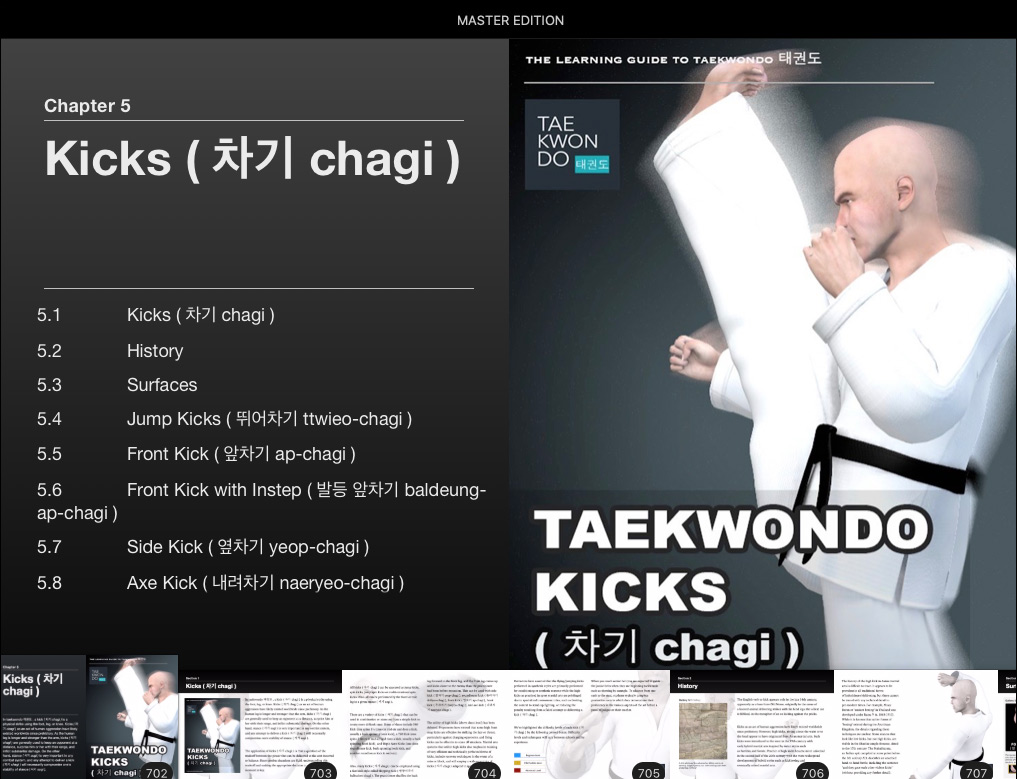
Taekwondo Preschool Master Edition

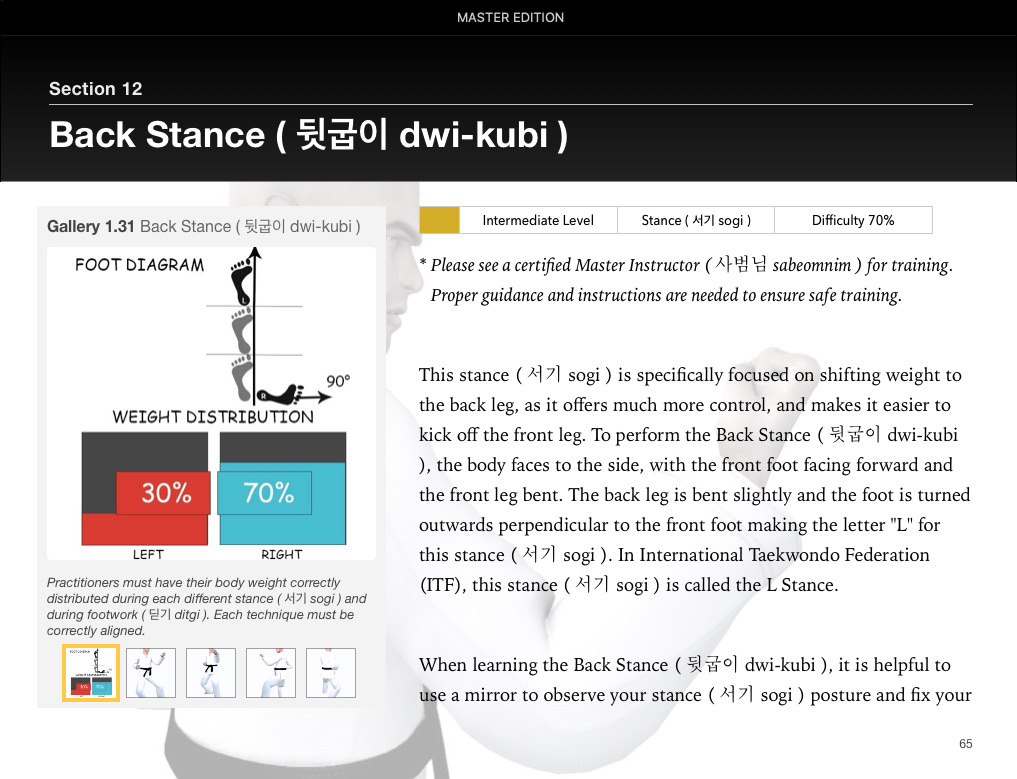
Taekwondo Preschool Master Edition
Sample: The Back Stance ( 뒷굽이 dwi-kubi ) is specifically focused on shifting weight to the back leg, as it offers much more control, and makes it easier to kick off the front leg


Taekwondo Preschool Master Edition
Sample: The Keumgang Punch ( 금강지르기 keumgang-jireugi ) is an advanced technique that requires you to punch ( 지르기 jireugi ) and block upwards ( 올려막기 olgul makgi ) at the same time

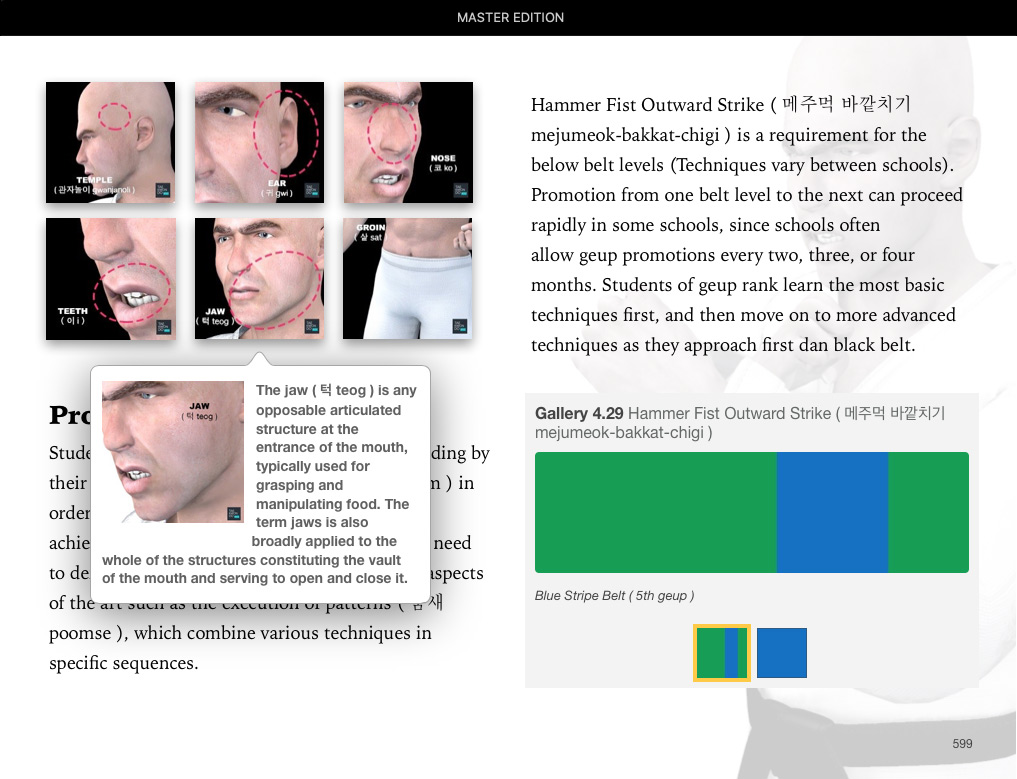
Taekwondo Preschool Master Edition
Sample: Hammer Fist Outward Strike ( 메주먹 바깥치기 mejumeok-bakkat-chigi ) is an intermediate strike that is delivered by hitting the opponent's chest to the upper area of the face with the closed fist sideways at full velocity

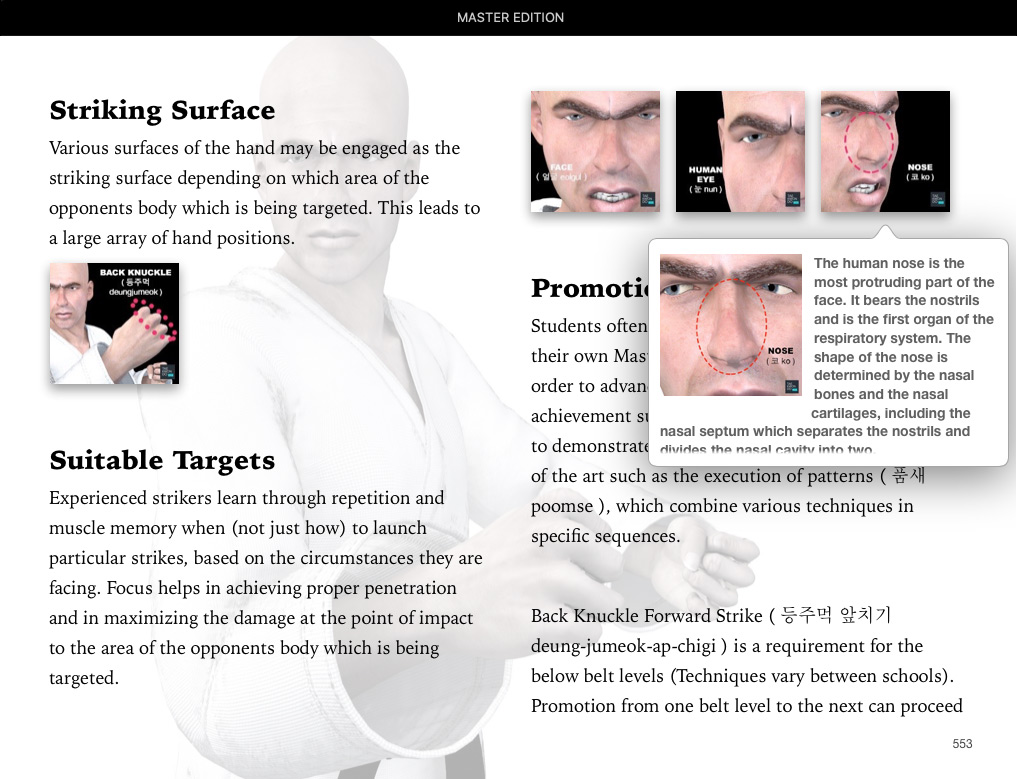
Taekwondo Preschool Master Edition
Sample: Back Knuckle Forward Strike ( 등주먹 앞치기 deung-jumeok-ap-chigi ) should pass over from the opposite waist to the armpit, to the chin level and then hitting with the back of the fist to the opponent's face


Taekwondo Preschool Master Edition
Sample: Knife Hand Inward Strike ( 손날 안치기 sonnal-an-chigi ) is an intermediate technique that is executed by striking with the muscle at the side of the hand located between the base of the small finger and the wrist

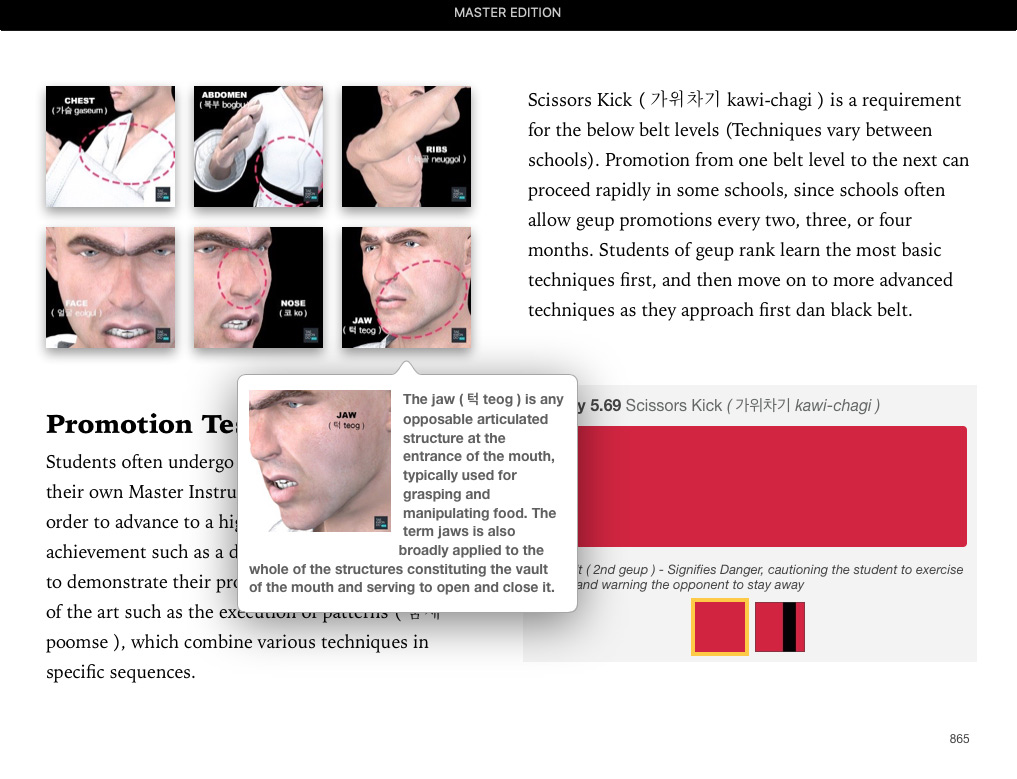
Taekwondo Preschool Master Edition
Sample: The Scissors Kick ( 가위차기 kawi-chagi ) is delivered while in the air moving forward into two opponents simultaneously after a running start to gain forward momentum


Taekwondo Preschool Master Edition
Sample: Promotion Testing or evaluation is important to martial art practitioners of many disciplines who wish to determine their progression or own level of skill in specific contexts

( Click image for additional information)
Additional Resources
Taekwondo Kicks ( 차기 chagi )

This book is available for download with Apple Books on your Mac or iOS device, and with iTunes on your computer. Book can be read with Apple Books on your Mac or iOS device.
Taekwondo is known for its emphasis on high kicking and fast hand techniques. A kick ( 차기 chagi ) is a physical strike using the foot ( 발 bal ), leg, or knee ( 무릎 mureup ). As the human leg is longer and stronger than the arm, kicks are generally used to keep an opponent at a distance, surprise him or her with their range, and inflict substantial damage. On the other hand, stance ( 서기 sogi ) is very important in any combat system, and any attempt to deliver a kick ( 차기 chagi ) will necessarily compromise one's stability of stance ( 서기 sogi ).
View more information about Book »
Taekwondo Kicks ( 차기 chagi ) |
|||||
| Hangul 한글 | Korean | Belt Requirement | Difficulty Level | Information | |
| Jump Kick | 뛰어차기 | ttwieo-chagi | Varies | Varies | Information » |
| Jumping Front Kick | 뛰어 앞차기 | ttwieo-ap-chagi |   |
Beginner Level | Information » |
| Jumping Side Kick | 뛰어 옆차기 | ttwieo-yeop-chagi |   |
Beginner Level | Information » |
| Front Kick | 앞차기 | ap-chagi |   |
Beginner Level | Information » |
| Front Kick with Instep | 발등 앞차기 | baldeung-ap-chagi |   |
Beginner Level | Information » |
| Front Kick with Ball of the Foot | 앞축 앞차기 | apchuk-ap-chagi |   |
Beginner Level | Information » |
| Side Kick | 옆차기 | yeop-chagi |   |
Beginner Level | Information » |
| Axe Kick | 내려차기 | naeryeo-chagi |   |
Beginner Level | Information » |
| Flying Kick | 두발당성차기 | dubaldangseong-chagi |  |
Beginner Level | Information » |
| Front Foot Kick | 앞발 차기 | apbal-chagi |  |
Beginner Level | Information » |
| Front Foot Front Kick | 앞발 앞차기 | apbal-ap-chagi |  |
Beginner Level | Information » |
| Front Foot Side Kick | 앞발 옆차기 | apbal-yeop-chagi |  |
Beginner Level | Information » |
| Front Foot Axe Kick | 앞발 내려차기 | apbal-naeryeo-chagi |  |
Beginner Level | Information » |
| Roundhouse | 돌려차기 | dollyeo-chagi |    |
Beginner Level | Information » |
| Instep Turn Kick | 발등 돌려차기 | baldeung-dollyeo-chagi |    |
Beginner Level | Information » |
| Back Kick | 뒤차기 | dwi-chagi |    |
Intermediate Level | Information » |
| Reverse Side Kick | 반대 옆 차기 | bandae-yeop-chagi |    |
Intermediate Level | Information » |
| Inward Crescent Kick | 안차기 | an-chagi |   |
Intermediate Level | Information » |
| Outward Crescent Kick | 바깥차기 | bakkat-chagi |   |
Intermediate Level | Information » |
| Whirl Kick 360º | 360도 돌개차기 | 360º dolgae-chagi |  |
Intermediate Level | Information » |
| Front Foot Roundhouse | 앞발 돌려차기 | apbal-dollyeo-chagi |  |
Intermediate Level | Information » |
| Hook Kick | 후려차기 | huryeo-chagi |   |
Intermediate Level | Information » |
| Counter Kick | 받아차기 | bada-chagi |   |
Intermediate Level | Information » |
| Rear Foot Counter Kick | 뒷발 받아차기 | dwitbal-bada-chagi |   |
Intermediate Level | Information » |
| Front Foot Counter Kick | 앞발 받아차기 | apbal-bada-chagi |   |
Intermediate Level | Information » |
| Skipping Kick | 발붙여차기 | balbucheo-chagi |  |
Intermediate Level | Information » |
| Skipping Front Kick | 발붙여 앞차기 | balbucheo-ap-chagi |  |
Intermediate Level | Information » |
| Skipping Side Kick | 발붙여 옆차기 | balbucheo-yeop-chagi |  |
Intermediate Level | Information » |
| Skipping Roundhouse Kick | 발붙여 돌려차기 | balbucheo-dollyeo-chagi |  |
Intermediate Level | Information » |
| Skipping Axe Kick | 발붙여 내려차기 | balbucheo-naeryeo-chagi |  |
Intermediate Level | Information » |
| Jumping Axe Kick | 뛰어 내려차기 | ttwieo-naeryeo-chagi |   |
Intermediate Level | Information » |
| Jumping Turn Kick | 뛰어 돌려차기 | ttwieo-dollyeo-chagi |   |
Intermediate Level | Information » |
| Jumping Inward Crescent Kick | 뛰어 안차기 | ttwieo-an-chagi |   |
Intermediate Level | Information » |
| Jumping Outward Crescent Kick | 뛰어 바깥차기 | ttwieo-bakkat-chagi |   |
Intermediate Level | Information » |
| Pushing Kick | 밀어차기 | mireo-chagi |   |
Intermediate Level | Information » |
| Pushing Front Kick | 밀어 앞차기 | mireo-ap-chagi |   |
Intermediate Level | Information » |
| Pushing Side Kick | 밀어 옆차기 | mireo-yeop-chagi |   |
Intermediate Level | Information » |
| Jumping Back (Thrust) Kick | 뛰어 뒤차기 | ttwieo-dwi-chagi |   |
Intermediate Level | Information » |
| Alternating Kick | 이어차기 | ieo-chagi |   |
Intermediate Level | Information » |
| Knee Upward Strike | 무릎 올려치기 | mureup-ollyeo-chigi |  |
Intermediate Level | Information » |
| Target Kick | 표적차기 | pyojeok-chagi |   |
Advanced Level | Information » |
| Front Foot Whip Kick | 앞발 후려차기 | apbal-huryeo-chagi |   |
Advanced Level | Information » |
| Spin Hook Kick / Back Roundhouse Kick | 뒤후려차기 | dwi huryeo chagi |     |
Advanced Level | Information » |
| Scissors Kick | 가위차기 | kawi-chagi |   |
Advanced Level | Information » |
| Twisting Kick | 비틀어차기 | biteureo-chagi |   |
Advanced Level | Information » |
| Jumping Back Whip Kick | 뛰어 뒤후려차기 | ttwieo-dwi-huryeo-chagi |   |
Advanced Level | Information » |
| Skipping Whip Kick | 발붙여 후려차기 | balbucheo-huryeo-chagi |   |
Advanced Level | Information » |
| Repeating Kick | 거듭 차기 | geodeup-chagi |   |
Advanced Level | Information » |
| Repeating Side Kick | 거듭 옆차기 | geodeup-yeop-chagi |   |
Advanced Level | Information » |
| Repeating Turn Kick | 거듭 돌려차기 | geodeup-dollyeo-chagi |   |
Advanced Level | Information » |
| Front Kick with Heel of Foot | 뒤축 앞차기 | dwichuk-ap-chagi |   |
Advanced Level | Information » |
| Turn Kick with Ball of Foot | 앞축 돌려차기 | apchuk-dollyeo-chagi |   |
Advanced Level | Information » |
| 360º Back Whip Kick | 360도 뒤후려차기 | 360º dwi-huryeo-chagi |  |
Advanced Level | |
| 540º Back Whip Kick | 540도 뒤후려차기 | 540º dwi-huryeo-chagi |  |
Advanced Level | |
| Whirl Kick 540º | 540도 돌개차기 | 540º dolgae-chagi |  |
Advanced Level | Information » |
| Whirl Kick 720º | 720도 돌개차기 | 720º dolgae-chagi |  |
Advanced Level | Information » |
| Whirl Kick 1080º | 1080도 돌개차기 | 1080º dolgae-chagi |  |
Advanced Level | Information » |
| Jumping Flip Kick | 공중제비차기 | gongjungjebi-chagi |  |
Advanced Level | Information » |
| Multi-Direction Kick | 다방향차기 | dabangyang-chagi |  |
Advanced Level | Information » |
| Single Line-up Break | 일렬격파 | illyeol-gyeokpa |  |
Advanced Level | Information » |
| Holding Kick | 잡고차기 | japgo-chagi |  |
Advanced Level | Information » |
| Holding Whip Kick | 잡고 후려차기 | japgo-huryeo-chagi |  |
Advanced Level | |
| Jump Two-Foot Front Kick | 뛰어 두발 앞차기 | ttwieo-dubal-ap-chagi |  |
Advanced Level | Information » |
Advertisement

Taekwondo Kicks ( 차기 chagi )
A kick ( 차기 chagi ) is a physical strike using the foot, leg, or knee. As the human leg is longer and stronger than the arm, kicks are generally used to keep an opponent at a distance, surprise him or her with their range, and inflict substantial damage. On the other hand, stance ( 서기 sogi ) is very important in any combat system, and any attempt to deliver a kick will necessarily compromise one's stability of stance ( 서기 sogi ). For more information View Taekwondo Kicks ( 차기 chagi ) »
- History of Kicking
- Front Kick ( 앞차기 ap-chagi )
- Side Kick ( 옆차기 yeop-chagi )
- Roundhouse ( 돌려차기 dollyeo-chagi )
- Spin Kick ( 뒤후려차기 dwi-huryeo-chagi )
- Jump Kick ( 뛰어차기 ttwieo-chagi )
- Jumping Front Kick ( 뛰어 앞차기 ttwieo-ap-chagi )
- Jumping Side Kick ( 뛰어 옆차기 ttwieo-yeop-chagi )
- Jumping Back Thrust Kick ( 뛰어 뒤차기 ttwieo-dwi-chagi )
- Jumping Turn Kick ( 뛰어 돌려차기 ttwieo-dollyeo-chagi )
- Front Kick with Instep ( 발등 앞차기 baldeung-ap-chagi )
- Front Kick with Ball of the Foot ( 앞축 앞차기 apchuk-ap-chagi )
- Front Kick with Heel of Foot ( 뒤축 앞차기 dwichuk-ap-chagi )
- Front Foot Kick ( 앞발 차기 apbal-chagi )
- Front Foot Front Kick ( 앞발 앞차기 apbal-ap-chagi )
- Front Foot Side Kick ( 앞발 옆차기 apbal-yeop-chagi )
- Front Foot Axe Kick ( 앞발 내려차기 apbal-naeryeo-chagi )
- Front Foot Roundhouse ( 앞발 돌려차기 apbal-dollyeo-chagi )
- Front Foot Whip Kick ( 앞발 후려차기 apbal-huryeo-chagi )
- Turn Kick with Ball of Foot ( 앞축 돌려차기 apchuk-dollyeo-chagi )
- Target Kick ( 표적차기 pyojeok-chagi )
- Twisting Kick ( 비틀어차기 biteureo-chagi )
- Scissors Kick ( 가위차기 kawi-chagi )
- Repeating Kick ( 거듭차기 geodeup-chagi )
- Repeating Turn Kick ( 거듭 돌려차기 geodeup-dollyeo-chagi )
- Repeating Side Kick ( 거듭 옆차기 geodeup-yeop-chagi )
- Knee Upward Strike ( 무릎 올려치기 mureup-ollyeo-chigi )
- Jumping Flip Kick ( 공중제비차기 gongjungjebi-chagi )
- Jump Two-Foot Front Kick ( 뛰어 두발 앞차기 ttwieo-dubal-ap-chagi )
- Multi-Direction Kick ( 다방향차기 dabangyang-chagi )
- Single Line-up Break ( 일렬격파 illyeol-gyeokpa )
- Back Kick ( 뒤차기 dwi-chagi )
- Reverse Side Kick ( 반대 옆 차기 bandae-yeop-chagi )
- Hook Kick ( 후려차기 huryeo-chagi )
- Axe Kick ( 내려차기 naeryeo-chagi )
- Outward Crescent Kick ( 바깥차기 bakkat-chagi )
- Inward Crescent Kick ( 안차기 an-chagi )
- Whirl Kick ( 돌개차기 dolgae-chagi )
- 360º Whirl Kick ( 360º도 돌개차기 360º dolgae-chagi )
- 540º Whirl Kick ( 540º도 돌개차기 540º dolgae-chagi )
- 720º Whirl Kick ( 720º도 돌개차기 720º dolgae-chagi )
- 1080º Whirl Kick ( 1080도 돌개차기 1080º dolgae-chagi )
- Pushing Kick ( 밀어차기 mireo-chagi )
- Pushing Front Kick ( 밀어 앞차기 mireo-ap-chagi )
- Pushing Side Kick ( 밀어 옆차기 mireo-yeop-chagi )
- Counter Kick ( 받아차기 bada-chagi )
- Rear Foot Counter Kick ( 뒷발 받아차기 dwitbal-bada-chagi )
- Front Foot Counter Kick ( 앞발 받아차기 apbal-bada-chagi )
- Alternating Kick ( 이어차기 ieo-chagi )
- Holding Kick ( 잡고차기 japgo-chagi )
- Holding Whip Kick ( 잡고 후려차기 japgo-huryeo-chagi )
- Skipping Kick ( 발붙여차기 balbucheo-chagi )
- Skipping Front Kick ( 발붙여 앞차기 balbucheo-ap-chagi )
- Skipping Side Kick ( 발붙여 옆차기 balbucheo-yeop-chagi )
- Skipping Roundhouse Kick ( 발붙여 돌려차기 balbucheo-dollyeo-chagi )
- Skipping Axe Kick ( 발붙여 내려차기 balbucheo-naeryeo-chagi )
- Skipping Whip Kick ( 발붙여 후려차기 balbucheo-huryeo-chagi )
- Flying Kick ( 두발당성차기 dubaldangseong-chagi )
- Jumping Back Whip Kick ( 뛰어 뒤후려차기 ttwieo-dwi-huryeo-chagi )
- Jumping Axe Kick ( 뛰어 내려차기 ttwieo-naeryeo-chagi )
- Jumping Inward Crescent Kick ( 뛰어 안차기 ttwieo-an-chagi )
- Jumping Outward Crescent Kick ( 뛰어 바깥차기 ttwieo-bakkat-chagi )
There are five tenets defined in the International Taekwondo Federation (ITF) and several more in World Taekwondo (WT).
Self-control ( 극기 geuk-gi ): "This means to not only have control over one's physical acts, but also their mental thoughts and actions." View Taekwondo Tenets »
RESOURCES
This article uses material from the Wikipedia article "Kick" which is released under the Creative Commons Attribution-Share-Alike License 3.0.








